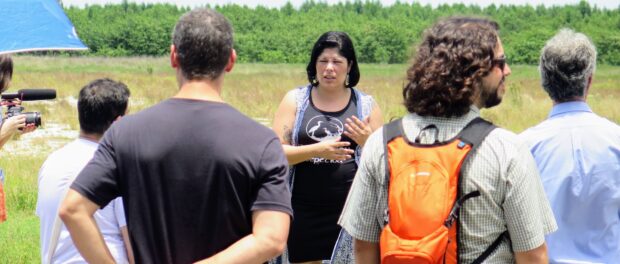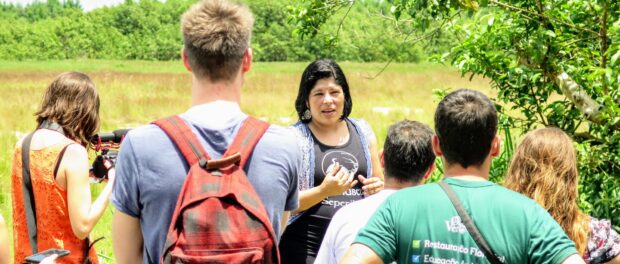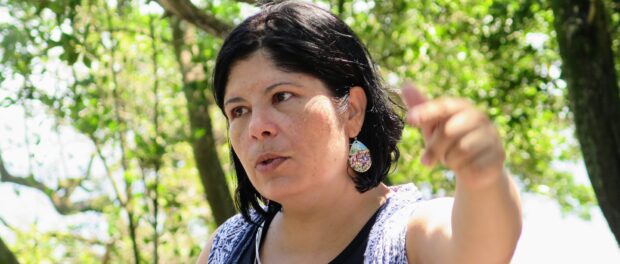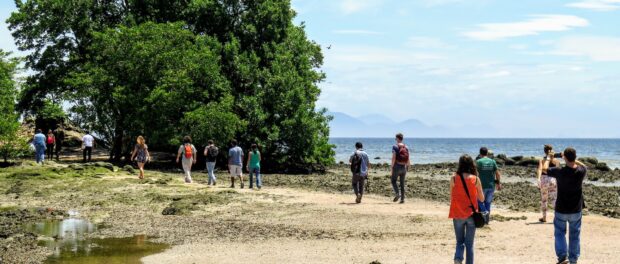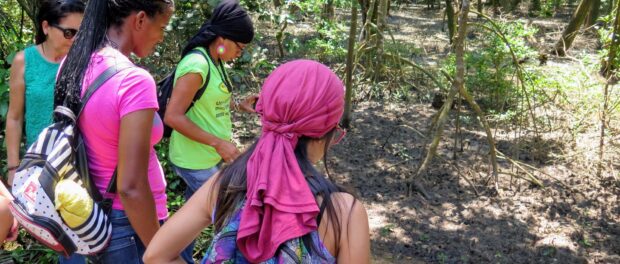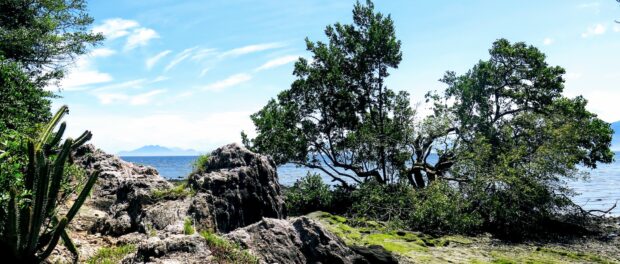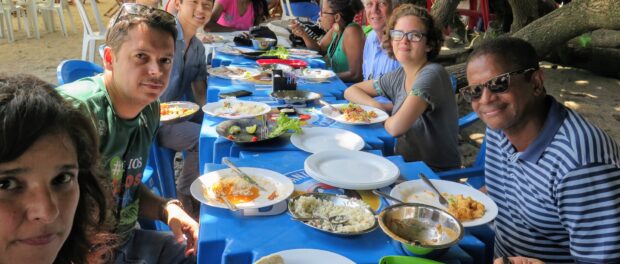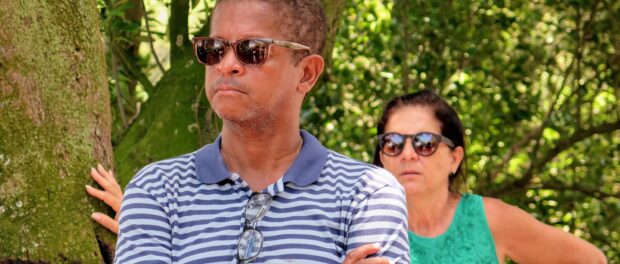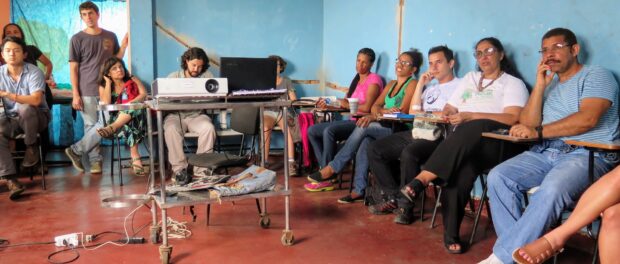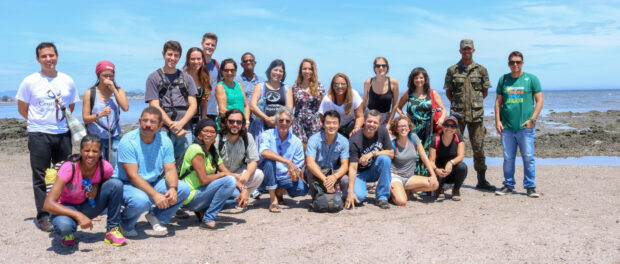
The Sustainable Favela Network (SFN) is a project of Catalytic Communities (CatComm)* designed to build solidarity networks, bring visibility, and develop joint actions to support the expansion of community-based initiatives that strengthen environmental sustainability and social resilience in favelas across the Rio de Janeiro Metropolitan Region. The project began with the 2012 film Favela as a Sustainable Model, followed in 2017 by the mapping of 111 sustainability initiatives and the publication of a final report analyzing the results.
In 2018, the project organized on-site exchanges among eight of the oldest and most established organizations that were mapped in the Sustainable Favela Network (one of which is the subject of this article), followed by a full-day exchange with the entire network that took place on November 10. The eight participants in the on-site exchanges featured in this series include six community-based organizations: the Vale Encantado Cooperative in Alto da Boa Vista, EccoVida in Honório Gurgel, Verdejar in Engenho da Rainha and Complexo do Alemão, Quilombo do Camorim in Jacarepaguá, ReciclAção in Morro dos Prazeres, and Alfazendo’s Eco Network in City of God. In addition, the exchanges visited two broader initiatives focusing beyond favelas with extensive experience in sustainability: Onda Verde in Nova Iguaçu and the Sepetiba Ecomuseum. The program is supported by the Heinrich Böll Foundation Brazil.
Watch the video that accompanies the exchanges featured in this series by clicking here.
The Fifth and Final Exchange: Sepetiba Ecomuseum
On the first Sunday of every month, a group of local educators and activists offers a glimpse at the history, culture, and environmental wealth of the neighborhood of Sepetiba, located at the extreme edge of Rio de Janeiro’s West Zone. For the past ten years, the Sepetiba Ecomuseum has developed a unique brand of grassroots social museology that works to represent one of Rio’s most socio-spatially segregated neighborhoods in a positive light. In the words of founding member Bianca Wild: “People only preserve what they love, and they only love what they know. So if you don’t know what’s in your neighborhood, you aren’t going to value it.” It was only fitting, then, for the last of the Sustainable Favela Network’s 2018 extensive exchanges to take place in Sepetiba, embarking on one of the Sepetiba Ecomuseum’s “Tours of Recognition.”
“Sepetiba has played a formative role in Brazil’s history. Sepetiba was present in colonial Brazil, imperial Brazil, and in the Brazilian Republic,” Wild told the SFN group before beginning the tour. She explained that recognizing the neighborhood’s historical significance can improve residents’ perceptions of their community, helping to remove the stigma of living far from Rio’s city center in a neighborhood that lacks consistent public services. In addition to Sepetiba’s history, the ecomuseum works to raise awareness of its rich natural environment. “Despite being degraded, the Sepetiba Bay is our natural heritage. In the past, it was called the ‘Bay of Miracles,'” Wild explained, describing how people would travel from all over seeking to treat a variety of illnesses using the bay’s mineral-rich mud. Wild’s account resonated with SFN members, including Vale Encantado’s Otávio Barros, who recounted stories of his mother and sister visiting Sepetiba for that very reason.
The Sepetiba Ecomuseum’s ‘Tour of Recognition’
While the Sepetiba Ecomuseum developed their monthly walks to encourage locals to rediscover their neighborhood, the tours have drawn the attention of visitors from across the city. On average, 70 to 80 people attend the monthly tours—reaching as many as 160 participants in some events. Wild told the SFN group that over the past decade, she has seen the positive impact of the Sepetiba Ecomuseum’s work, but that there is still lots of work to be done. The group hopes to create more trails in the coming years, attract more residents to participate in their tours, and make the walks accessible to those with disabilities. In Wild’s words, ensuring that the Ecomuseum’s trails are universally accessible is “fundamental to elevating the self-esteem of local residents.”
Sepetiba’s unequal access to public services due to its location sparked a response from the previous exchange’s point of focus, the community group Alfazendo in City of God, also located in the West Zone. Alfazendo representative Carlos Alberto Oliveira lamented Rio’s model of development that, for more than fifty years, has relied on removing lower-income citizens from the center of the city and moving them into peripheral communities lacking in physical infrastructure, education, and other public services—a history he has seen repeated in Sepetiba, City of God, and across the city. “What we learned with our history is that we also have to be alert, because this is going to keep happening… It’s not surprising because, after all, we are black and poor. [But] we are going to occupy [these] spaces,” Oliveira said.
Following the path through some of Sepetiba’s most important natural heritage sites, the group paused to discuss the growth of mangrove swamps in the Sepetiba Bay. Wild, along with Sepetiba Ecomuseum representative Aline Barcellos, noted the ecological role that mangroves play in the local ecosystem, helping recover the area’s crab population and functioning as an ecological barrier to waste disposed of in the bay.
In the words of Barcellos: “The mangroves are actually ‘feedback’ that nature gives in response… trying to remediate pollution.” SFN members contributed their knowledge of mangroves, with Onda Verde representative Diogo Luiz explaining that “mud in the mangroves is not pollution.” Despite local opposition among some residents who consider it aesthetically unattractive, the mud is important in helping the mangrove grow. Environmental engineer Leonardo Adler, who helped build the Vale Encantado community’s sewage biodigester, added on, explaining how mangroves serve as natural water filters similar to the system in Vale Encantado: “In Portuguese, we call the post-treatment technology for effluent from the biodigester an ‘area of roots’—but in English, it’s called a ‘constructed wetland.’ And wetlands are flooded areas such as mangrove swamps… They’re plants that filter nitrogen, phosphorous, and potassium so that the water that is released is already treated.” Wild and others from the Sepetiba Ecomuseum were excited to learn more about the mangroves swamps’ ecological importance.
The Unequal Distribution of Environmental Risk
After lunch of fresh local fish on the Sepetiba Bay, the Sustainable Favela Network group reconvened to hear Rafael Chaves, a doctoral collaborator in the Department of Geography at the Federal University of Rio de Janeiro (UFRJ), present his research on the uneven distribution of environmental risk in Brazil. Chaves began by thanking the SFN participants for the knowledge they had shared over the course of their exchanges and offering his technical perspective as another set of tools for participants to use in thinking about their individual work. He then summarized his work surrounding risk and inequality, explaining that environmental risk is unevenly distributed depending on the social classes inhabiting certain spaces. Differentiating Brazilian society between an “elite” and a “working class,” Chaves discussed the ways in which unequal access to public services, capital, and land markets results in the lower classes being forced to inhabit areas of greater environmental risk. At the same time, he said that the government and the elite also habitually use discourse surrounding environmental risk to justify the removal of communities that allegedly present a threat of environmental degradation.
Chaves concluded his presentation by specifically linking these areas of risk to the creation of favelas, saying: “These lands, which present greater risks for human occupation due to their natural characteristics end up being occupied exactly by those people without access—because of a series of historical factors—to more secure lands.” These people, he explained, are then responsible for mitigating the risks of inhabiting these areas: “They are the ones who get their hands dirty in order to reduce the vulnerability [both occupational and environmental] of these spaces.” For this reason, Chaves identified favelas as a housing solution—one that citizens largely neglected by the government and elite created on their own.
Sharing Dreams, Strengthening the Network
To conclude their visit to Sepetiba, each of the day’s participants discussed the dreams they hold for their projects in the coming year. Bianca Wild began the conversation with the Sepetiba Ecomuseum’s hope to reach more residents. Cris dos Prazeres of ReciclAção described that she has a similar goal in mind and hopes to strengthen the “collective consciousness” in her community, Morro dos Prazeres, to ensure future generations value the organization and continue with its work. Iara Oliveira from Alfazendo’s Eco Network, based in City of God, contributed a different perspective, saying that her “greatest dream is for our [work] to no longer be necessary.” Ideally, the government would address the inequalities and injustices facing communities such as City of God through effective public policies, which would relieve civil society organizations like Alfazendo from responsibilities that should be carried out by competent public authorities. Recognizing that her dream may not become a reality for the foreseeable future, Oliveira said she is focused on bolstering youth engagement in City of God and by strengthening networks with like-minded institutions across the city. Reflecting on the similarities in methodology between the Sepetiba Ecomuseum and Alfazendo’s Eco Network, the groups’ representatives brought up the possibility of hosting exchanges between their communities.
Vale Encantado’s Otávio Barros shared a specific set of goals for the upcoming year, including his hope to connect the community’s ecological sanitation system to as-of-yet unconnected homes, finish the construction of a cooperative kitchen capable of producing food for residents and visitors alike, and increase the environmental awareness of Vale Encantado’s residents. Meanwhile, Onda Verde’s Helio Vanderlei reflected on the difficulty of dreaming at all, when organizations must focus on planning everything from volunteer commitments and institutional partnerships to finances and operations. With these considerations in mind, Vanderlei suggested that SFN members create a spreadsheet for each project to list their goals and describe how others within the network could help them achieve their objectives—an idea met with widespread agreement. The group soon began discussing what each group hoped the Sustainable Favela Network could contribute to their work in the year to come, and how they could contribute to the Network in return. After five full-day exchanges, the day’s conclusion gave a glimpse into the growing potential of the Network, and the strength and resilience its members had already built.
Read up on all of the 2018 Sustainable Favela Network exchanges here.
Watch the video of all five days’ exchanges now:
*RioOnWatch is a project of the NGO Catalytic Communities

